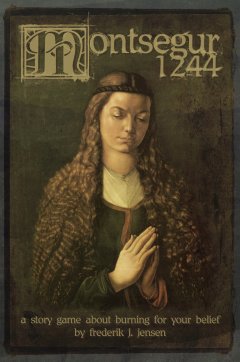I started to feel that I didn’t know roleplaying games well enough so I came up with the plan to read a roleplaying game corebook for every year they have been published. Selection criteria is whatever I find interesting.

Montsegur 1244 is a storygame about the fall of the Cathars in the titular Montsegur fortress. It’s a historical game asking the participants to take on the roles of Cathars on a tightly scripted journey towards their doom. The siege will end with the faithful burning on a pyre. The only question is, what are the individual journeys and scenes like as they get there?
There’s an explicitly framed question at the heart of the game: What made so many of the Cathars choose to die a horrible death instead of recanting their faith? This is the choice offered by the besieging army: The defenders could leave and be free if they recanted. If they stuck to their beliefs, they’d burn.
Since the only people who could answer that question were burnt to death the players are free to seek their own journeys and reasons for why their characters end up like that. The game doesn’t demand it of every player character but at least one must die.
As often happens while I read roleplaying games, I’m trying to suss out the desired playstyle and see how it fits with my own play culture. On a quick read, Montsegur 1244 reads just like the kind of character-based game I like. Get really into your role and wrestle with difficult choices!
On closer examination, this is not the case. There’s a clue in the extremely pared down characters, the major substance of which consists of three questions about who they are. Your goal as a player is to find answers by the end of the game. Thus, you create the particulars of your character on the fly.
This means that the emotional position of the player is a bit more abstract, more about the scenario and the story than the person of the character. The role is a vehicle to explore the issues, not a three-dimensional character to emphasize with.
Considering the tight focus of the game, it’s actually quite extravagant in terms of production: There’s a game board, cards, handouts. enough stuff to make it a proper boxed set! Despite the plethora of fun materials, the basic design is very simple. The game is divided into acts, and during each act the players propose and play scenes. At the end of the predetermined act structure, the players make the final choices about who escapes and who burns.